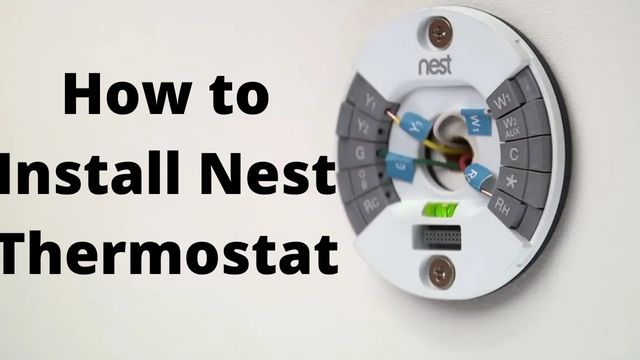How to Install Nest Thermostat

Setting up the $130 Nest Thermostat is not too difficult. We’ll demonstrate how to install nest thermostat?
How to install Nest thermostat
Installation, setup, and programming or learning are the main three stages of this process.
- Step 1: Installing the Nest app should be your first priority. The Nest app’s step-by-step instructions and wealth of instructional videos and pictures are its strongest feature.
- Step 2: Next, turn off the power to the HVAC system in your house. Even though the majority of furnace systems operate on low voltage, you should nevertheless turn off the system’s breaker for safety.
- Step 3: Take off the cover on your present thermostat. Snap a picture of the current wiring. You’ll need this for future use as a guide.
- Step 4: Disconnect the wires and identify them. Use the little labels that Nest provides you with to keep track of which wires are which.
- Step 5: Remove the outdated thermostat. Attach the new Nest wall plate and base after removing the old base and wall plate. Ensure that everything is level and attractive.
- Step 6: The wiring of your new Nest thermostat is now complete. Utilizing the wiring schematic from the Nest app, attach the wires to the base of your Nest thermostat.
- Step 7: Next, connect the Nest faceplate in step seven. Clip the new faceplate on, then wait for the magic to happen. This is the fun part.
- Step 8: Restore the power. Your Nest should start up on its own after the power has been restored. Sometimes, it might first need to charge up a little.
- Step 9: Now that the faceplate is functional, the app will assist you with the remaining steps, which require selecting certain settings and preference.
- Step 10: Program your thermostat on the app or, if you chose the Nest Learning Thermostat, it will begin its learning phase, which could take a few weeks.
A Nest thermostat may be set up quickly and easily. You can easily complete this in an evening or over the weekend, even if it does require some time—allocating approximately an hour from start to finish, including programming time, is a good suggestion. It will also take some time for those energy savings to show up on your heating bill, but that’s okay because implementing a system like a Nest thermostat is a long-term strategy.
For people who need to control the temperature in vacation homes, second houses, or office buildings, Nest thermostats are also fantastic. With the help of the Nest app, you can accomplish a lot from your smartphone without wasting energy.
Google’s newest smart thermostat is the $130 Nest Thermostat, which should not be confused with the $250 Nest Learning Thermostat.
Tired of regulating the temperature in your house by hand? Tired of paying such high energy costs in the summer and winter? A Nest Thermostat seems like it might be a smart purchase.
Nest Thermostats, which are produced by Google, are web-connected smart thermostats that let you manage the temperature in your house from a distance using a phone, tablet, or even voice commands through a compatible smart speaker or smart display.
Installing a Nest Thermostat, which comes in a variety of models and generations, requires some effort and patience but is completely do-it-yourself (DIY) if you’re ready to set out an hour on your next free weekend.
Can you install a Nest Thermostat?
Since there is wiring to consider, installing one of these smart gadgets may appear challenging and daunting to some people. In actuality, companies like Nest have made installing a smart thermostat so simple that anyone can do it, even if they have no prior knowledge of electrical wiring. Here is all the information you require.
Decide on your level of smarts: Choose your Nest
At least with a Google Nest thermostat, you will have an option to make before installation: the particular model.
There are several versions available from Nest, including the first Nest Learning Thermostat and the more recent 2020 Nest Thermostat. Both install very similarly.
The leading model is the Nest Learning Thermostat. As the name implies, it gets to know your house and your arrivals and departures, and it can regulate temperatures on its own.
Then, over time, it modifies your energy use based on this pattern of recognition. The Nest Learning Thermostat costs about $249, but it is quite intelligent (and has smartphone and voice control).
Late in 2020, the updated Nest Thermostat was introduced. This might be considered a budget model. With a price tag of about $129, it is much more affordable than previous smart technologies.
The thermostat will need to be programmed by you, but other from that, you still get a smart, flexible thermostat with voice control and a companion app for a terrific price that understands when you’re home and when you’re not.
Check your furnace compatibility
Make sure the item will work with your furnace before clicking the Buy button. On the Nest website, you can browse before you buy.
To believe you’re ready to add cutting-edge technology to your house only to have to ship it back for a refund is frustrating. Visit the Nest website to check ahead of time and avoid frustration.
How would you know? Simply remove the cover from your current thermostat to reveal the cables inside. Enter your discoveries in the website checker, then wait for your findings.
Look for a C-wire
In some circumstances, you will want a C-wire in order to power your thermostat effectively. One of the cables that connects the furnace to the thermostat is called a C-wire. You can see what you have if you take a peek behind the cover.
A Nest Learning Thermostat should function with an older furnace system without a C-wire, but the new 2020 Nest Thermostat may not.
Although Nest Thermostats are simple to install on your own, you may also ask an HVAC professional for assistance. You are now prepared to install your Nest Thermostat with compatibility confirmed.
How to install a Nest Thermostat without a C-wire
Your HVAC system might not even have a C-wire, depending on how your property is wired. The C-wire has always been a necessary component of attaching any type of contemporary thermostat, but if you don’t have one, don’t panic.
You can purchase a C-wire adaptor from Google to connect your new Nest without having to budget for hiring a specialist to install a new C-wire.
Once you’ve obtained a C-wire adapter, complete the following procedures to connect it to your home’s HVAC system and, ultimately, to your Nest thermostat.
Remember that the C-wire adapter is only compatible with third-generation Nest Thermostat products and is only compatible with 24 VAC systems.
- Step 1: As mentioned in the previous section, you should turn off the electricity to the HVAC system first. Then, proceed to removing the Nest Thermostat’s faceplate to reveal the wiring terminals below.
- Step 2: Attach the C-wire adapter to the zone controller or air handler on your furnace. Simple to follow instructions are provided in the adapter kit.
- Step 3: After the adapter has been installed, attach the remaining leads to the correct terminals and replace the thermostat’s faceplate.
- Step 4: Reconnect your HVAC system to the power. Your Nest Thermostat should now start up successfully.
Conclusion
Although your thermostat is fitted, your work is not yet complete. Your favorite language, the kind of system you have, and other questions will now be asked of you via the Google Home app. Aside from scheduling your heating and cooling, you may also enable Home/Away Assist, a feature that uses built-in sensors to detect whether you’re home or not and adjusts the temperature for you accordingly.
People May Ask
Q- A Nest thermostat may it be installed by you?
A- Installing a Google Nest thermostat is often a quick DIY process that takes 20 to 30 minutes. Use the Nest app as your primary reference because its step-by-step instructions make wiring and installing your thermostat simple. If you require additional assistance, consult this article.
Q- Does the Nest thermostat need to be wired?
A- Since they are made to consume very little power, Nest thermostats frequently acquire adequate steady electricity by using the heating and cooling connections in your system. To make your system compatible, however, you might occasionally need to connect a common wire (C wire) or a power accessory, such as the Nest Power Connector.






